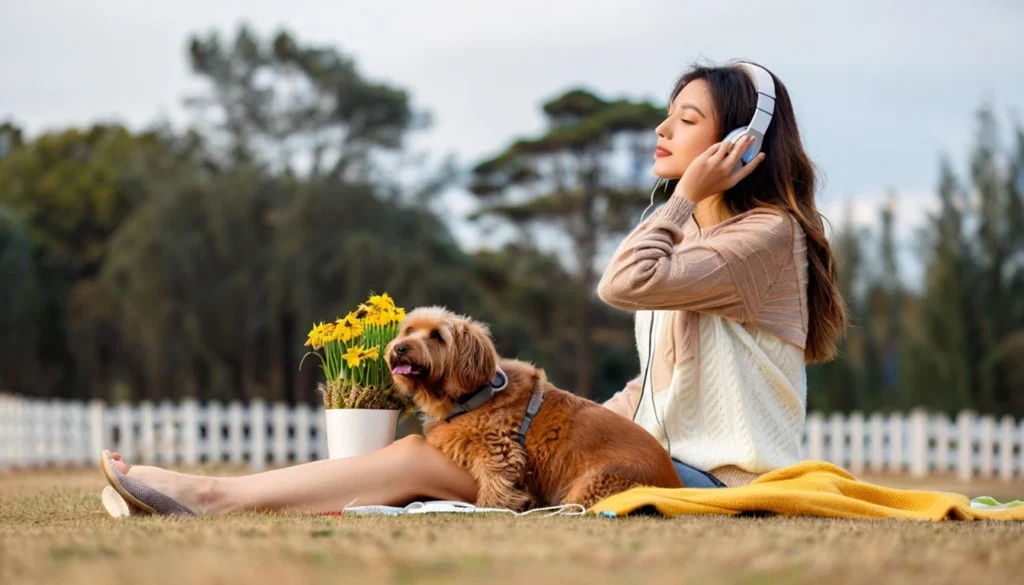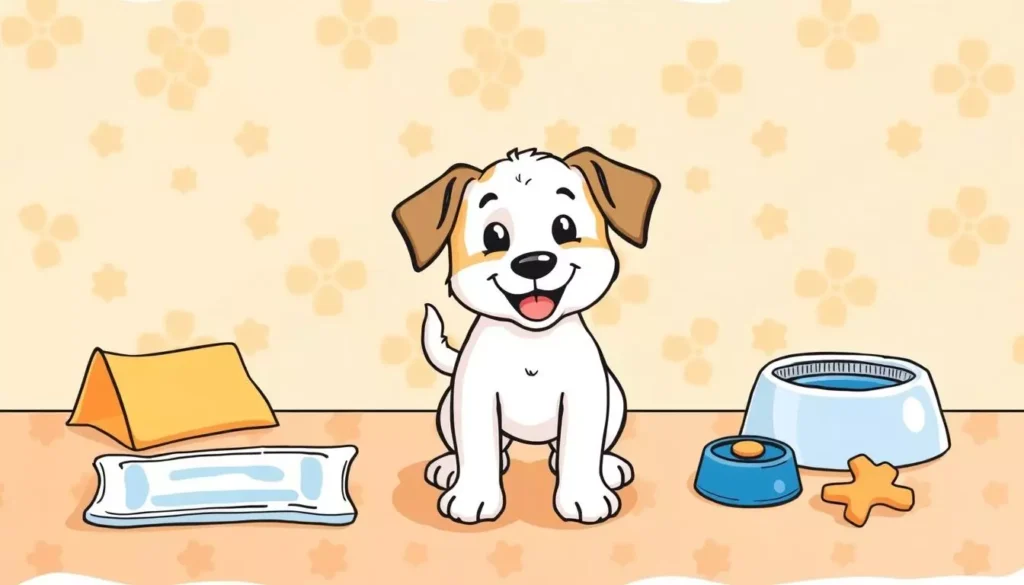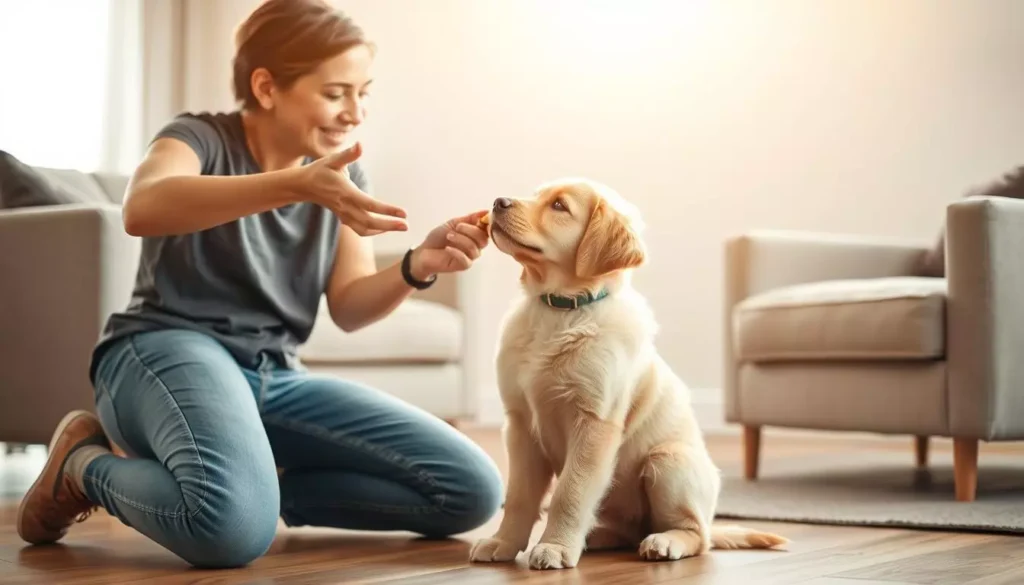I remember the first night I brought my Labrador home. I felt joy and panic. Training was like learning a new language, shaping our days and walks.
I start with simple obedience training. It uses positive methods and short, fun sessions. For early lessons, use treats. Practice often, not in long sessions.
My method is based on the American Kennel Club's ideas. It builds a language with words, signals, and routines. Early skills like sit and stay boost confidence and prepare for more.
Key Takeaways
- Begin with short, frequent training sessions to keep learning fun and effective.
- Use positive reinforcement techniques — treats, toys, praise, and life rewards.
- Focus first on basics: sit, stay, come, crate habits, and outside pottying.
- Build consistency with daily routines for feeding, play, naps, and potty breaks.
- Combine voice commands and hand signals to form a clear, unspoken language.
Why I Believe in Reward-Based Training and Positive Reinforcement Techniques
I believe in reward-based training because it teaches good behavior without fear. Positive reinforcement shows dogs that working with me is rewarding. This makes training fun and a team effort, not a fight.
I start by marking the exact moment a dog does what I want, then reward them. Clicker training is great for this. It clearly tells the dog, "Yes, that was it," linking rewards to actions.
I prefer short, frequent training sessions. They help dogs focus and avoid getting frustrated. Using a treat pouch and short sessions during meals helps them learn fast and remember commands.
Reward-based training makes dogs less fearful and more willing to try new things. Owners who use positive reinforcement see their dogs learn faster and control their impulses better. The American Kennel Club says rewards build a strong bond between dog and handler.
For rewards, I use treats, toys, praise, and freedom to play or go outside. At first, I use food a lot, then switch to treats and praise as behaviors become consistent. This keeps the dog motivated during advanced training.
Clicker training fits well into this approach. The click marks the action, and then I reward them. Over time, the click alone is enough, and I change rewards to keep them interested and skilled in different situations.
Starting Right: Puppy Training Tips for the First Weeks at Home
Bringing a puppy home is exciting but can be chaotic. It's best to start with a calm and clear approach. This balances routine with fun, short lessons. Early months are crucial for dog training and make later work easier.
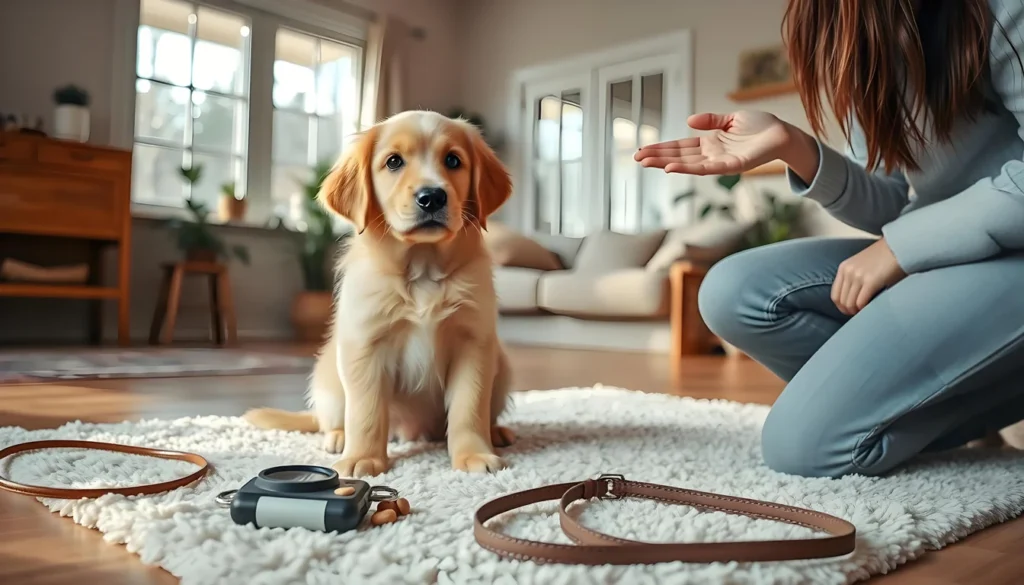
Creating a simple puppy training schedule is key. I feed at set times and add potty breaks after meals and naps. I also have two to three short 5–10 minute training sessions.
Using mealtime for training makes food a reward. I ask for Sit and Come before giving the bowl. This teaches puppies to work for rewards.
To teach name recognition, I say the puppy’s name in a happy tone and reward quick eye contact. I play a short name game: call the name, wait for a glance, mark it with a tiny treat, then release to play. This improves focus and response for later training.
Nipping and chewing are normal in young pups. I prepare safe chew toys and swap them in when mouthing begins. If biting gets rough, I redirect to a toy and reward the exchange. Crate-threshold drills help with impulse control: I ask for calm at the doorway, reward calm behavior, and only open the gate when the puppy is composed.
Short training windows, a steady schedule, and clear rewards make progress fast. I keep sessions playful to prevent frustration. Early attention-building, mealtime drills, and smart redirection of chewing lay the groundwork for a well-mannered dog.
| Focus Area | Action | When | Why |
|---|---|---|---|
| Daily Routine | Set fixed feeding, potty, play, and nap times | Begin at 8–10 weeks | Creates predictability and supports housetraining |
| Mealtime Training | Require Sit and Come before bowls | At each feeding | Uses food as reward to teach basic cues |
| Name Recognition | Play short name-contact games with treats | Multiple times daily | Builds attention and recall foundation |
| Nipping & Chewing | Redirect to chew toys; reward exchange | When mouthing occurs | Teaches bite inhibition and appropriate outlets |
| Crate Threshold | Reward calm at crate entrance before exit | During arrival and departures | Teaches impulse control and safe crate use |
Crate Training and Housetraining to Build Trust and Routine
To make a crate a dog's den, start with soft bedding and favorite toys. Feed meals near the crate and reward calm entry. This makes the crate inviting.
Begin with short, positive sessions. Close the door for a minute, then return and praise. Gradually increase time, watching for stress signs. This method supports crate training and housetraining by limiting roaming.
How to introduce a safe resting area
Integrate the crate into daily life. Place it in a family room where the dog can see people. Never use it for punishment. Treats and meals near the crate create a positive link.
Potty timing using an age guideline
Housetraining begins on day one. Use the age-in-months rule for potty schedules. A puppy can usually hold its bladder for half its age in months, in hours. Schedule breaks after naps, meals, and play.
Managing accidents and checking health
Accidents are normal. Stay calm and clean with an enzyme cleaner. If accidents persist, a vet check is necessary to rule out health issues.
Some urination issues are behavioral, like submissive or excitement urination. Use low-pressure methods to reduce anxiety. Short sessions, predictable routines, and gentle desensitization help manage stress and improve control.
| Step | Action | Why it helps |
|---|---|---|
| Introduce crate | Feed near crate; leave door open; add bedding | Creates positive association and a safe space |
| Short confinement | Close door briefly; praise calm behavior | Builds tolerance without stress |
| Potty schedule | Use age-in-months/2 hours rule; tie to mealtimes | Sets clear expectations and reduces accidents |
| Crate threshold pause | Practice calm waiting before exit | Teaches impulse control and smoother outings |
| Accident response | Stay calm; clean thoroughly; track patterns | Prevents repeat marking and informs troubleshooting |
| Persistent issues | Consult veterinarian; add behavior work | Rules out medical problems and guides training |
Leash Training Exercises and Loose-Leash Walking Strategies
I start leash work indoors to make a puppy comfortable with a harness. Short sessions help them get used to it before going outside. This early practice builds confidence and sets the stage for future training.
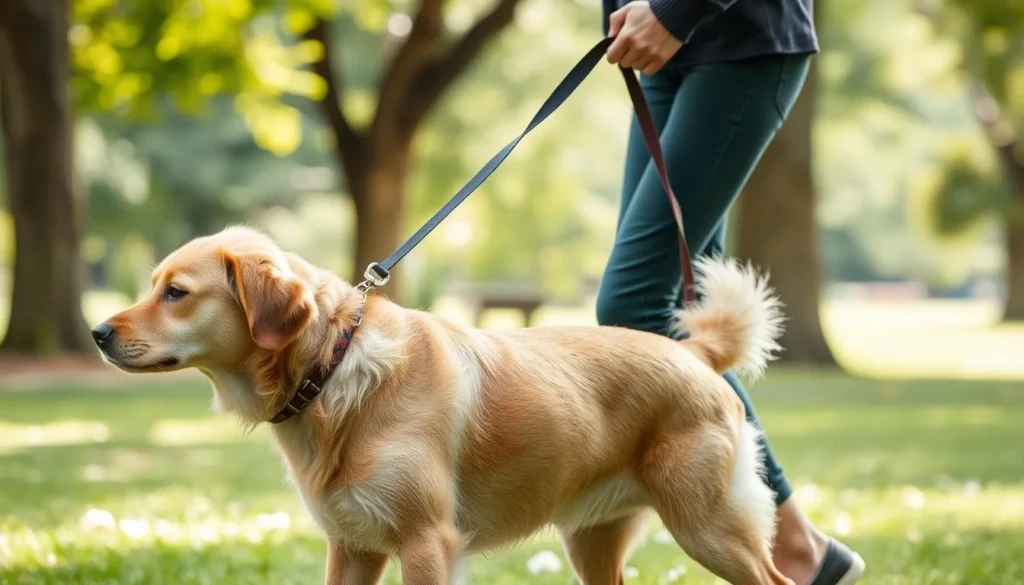
I use gentle play and treats to introduce the leash and harness. I choose lightweight harnesses from brands like Ruffwear or Kurgo for puppies. Letting them move around the living room helps them feel safe.
When they stay calm, I reward them with treats. This links the harness to positive feelings.
Then, I move to focused exercises in quiet spots like driveways or yards. I practice recalls, attention cues, and short heel steps. These exercises help with loose-leash walking and make longer walks easier.
I use no-pull harness techniques when pulling is a problem. I pair it with rewards to make it a training tool. Teaching the Heel command involves marking the moment they walk beside me and rewarding them quickly.
To progress, I increase the distance and duration slowly. I start with small steps and gradually go further. I use high-value treats in busy areas to keep their focus on me.
I also work on preventing lunging near bikes, other dogs, or busy sidewalks. I teach them to ignore distractions by calling their name and rewarding them for staying focused. If they pull, I shorten the session and go back to easier exercises.
If training doesn't go well, I seek help from a professional dog trainer. A trainer can adjust the training to fit your dog's needs. They can also suggest specific techniques or session plans.
Socialization Practices to Prevent Fear and Build Confidence
I start socializing puppies early to help them grow into calm, adaptable adults. Early exposure to safe family members, calm dogs, and controlled new experiences helps reduce fear. It also sets the stage for steady learning. I watch body language closely and step in when interactions look risky.
I focus on quality over quantity when introducing people and pets. Short, positive meetings with matched personalities lead to better outcomes than long, chaotic sessions. I use barriers like playpens so a pup can observe first, then progress to supervised contact when the puppy shows comfort.
I use simple desensitization to common noises and environments. I play recordings of traffic and construction at low volume, pair sounds with treats, and increase exposure slowly. This reduces startle responses and prevents long-term phobias.
When I see persistent fears or aggressive signals, I consult a canine behavior specialist. Their assessment helps me choose the right behavior modification methods and avoid approaches that could make fear worse. I value guidance for complex cases and when progress stalls.
Below I compare practical socialization steps, typical timelines, and who to call if help is needed.
| Focus | What I Do | Timing | When to Call a Professional |
|---|---|---|---|
| Family introductions | Short visits, calm adults, reward calm behavior | Begin within first weeks, repeat weekly | If pup shows persistent fear or retreats |
| Other dogs | Start with calm, vaccinated dogs behind a barrier | Gradual, supervised meetings over months | If growling or escalation occurs |
| Noises and environments | Controlled recordings, car rides, park visits | Short sessions several times per week | If pup freezes, panics, or avoids places |
| Play quality | Match play style, stop rough play, teach breaks | Ongoing; monitor every session | If play routinely ends in fights or fear |
| Behavior plans | Reward-based steps and small progress goals | Weekly reviews and monthly milestones | When standard behavior modification methods fail |
Essential Obedience Commands I Teach and Why They Matter
I start every dog training with a few key commands. These commands help keep dogs safe and organized. Sit, Come, Stay, Down, and Place are taught early to set clear expectations.
Core commands: Sit, Come, Stay, Down, Place
I teach Sit and Come using food during meals. Puppies learn these quickly with a reward. Place and Down are added later, with Place being a calm spot for dogs.
I keep training sessions short to match a puppy's focus. Small victories boost confidence and keep training positive.
Teaching recall and proofing it at increasing distances
Recall training starts close and gets longer. I use a long line for safe distance practice. Every successful recall is rewarded to make it more appealing than wandering off.
Proofing means adding more distance, time, and distractions in small steps. I start in the living room, then move to the yard and parks, adding distractions gently. Each step must be reliable before I add more challenges.
Linking commands and building reliable sequences
Once basics are mastered, I link commands into sequences. Sit > Down > Stay > Come > Place are common sequences. This teaches dogs to switch between actions and improves control.
I gradually reduce treats and use rewards less often. This keeps behavior strong without constant rewards. It makes training practical and reliable in everyday life.
Clicker Training for Dogs and Marker-Training Methods
I use clear signals to teach my dog, and clicker training is perfect for this. The clicker's sound marks the exact moment a dog does what I want. This makes learning fast and keeps us both happy.
How a clicker creates clear communication
The clicker is like a marker that shows when a dog does something right. When I click and then give a treat, the dog learns to expect a reward. This is the heart of marker-training and positive reinforcement.
Steps to start clicker training for basic and advanced behaviors
I start by linking the clicker with treats. Then, I click for small steps towards the goal, a method called shaping. For simple commands like sit and come, I click the exact moment they do it right.
As they get better, I make the tasks harder slowly. For harder tricks, I use clicks to link each step. Being consistent with timing is key for good dog training.
Transitioning from continuous treats to intermittent rewards
When a dog is reliable, I start giving treats less often. By four to six months, I ask for several actions before a treat. I also use praise, petting, or toys as rewards sometimes.
Using treats less often keeps the dog's interest high. It also helps them learn to do things even when distracted or things change.
| Training Phase | What I Do | Why It Works |
|---|---|---|
| Charge the clicker | Click then reward repeatedly until the sound predicts treats | Builds the click as a reliable marker for the dog |
| Shaping small steps | Click for approximations, reward each improvement | Breaks complex behaviors into learnable actions |
| Chain and proof | Link clicks for multi-step behaviors and practice in distractions | Creates dependable responses across settings |
| Wean treats | Shift to praise, petting, and variable food rewards | Prevents treat dependency while maintaining skill |
Behavior Modification Methods for Common Issues
I help owners find ways to reduce stress for dogs and people. We start by finding what triggers the problem. Then, we teach the dog a new way to act and reward them for it.
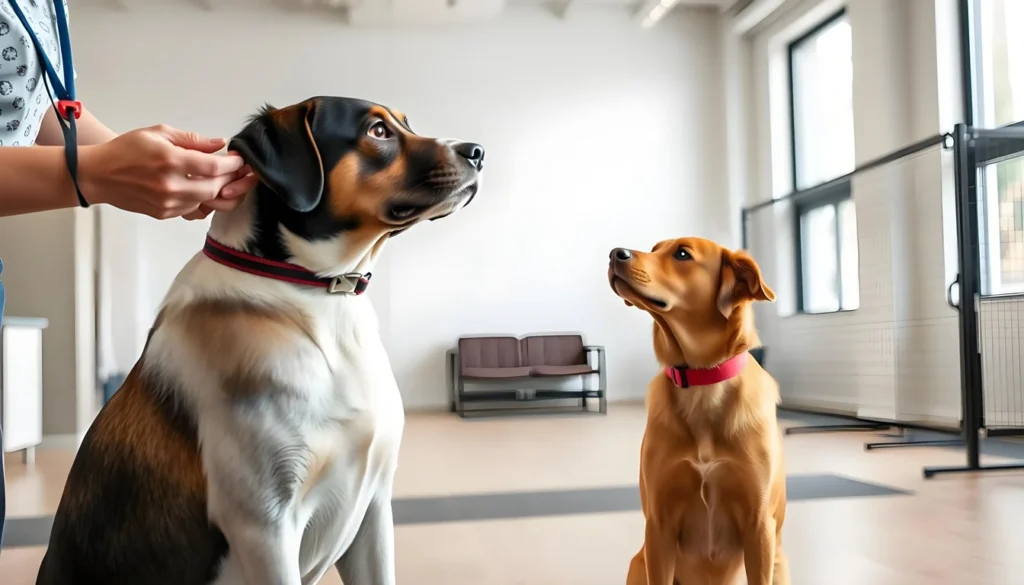
Addressing jumping, mouthing, and excessive barking
To stop jumping, I teach the dog to sit at the door instead. We reward them with treats or praise for calm behavior. This teaches them a new, better way to greet.
Mouthing can be fixed by giving the dog chew toys and teaching them to play gently. If play gets too rough, we use time-outs. We reward them for gentle play.
For too much barking, we use training and management. We teach the dog to be quiet on command and give them toys and activities to keep them busy.
Strategies for submissive and excitement urination
Submissive urination is caused by fear. Excitement urination happens when dogs get too excited. Both need calm handling and regular routines.
We make arrivals calm by being quiet and not looming over the dog. We teach them to sit before we interact. We reward them for calm behavior and slowly get them used to triggers.
Before starting training, it's important to check with a vet to rule out health issues. Then, we focus on building the dog's confidence and gently changing their behavior.
When to consult a veterinarian or a canine behavior specialist
If training doesn't work or if the behavior is dangerous, see a vet first. They can check for health problems. If it's still a problem, a canine behavior specialist can help.
A specialist will create a plan just for your dog. They'll help with controlled training and work with your vet if needed. This way, your dog and family stay safe and happy.
Advanced Training, Tricks, and Mental Stimulation
I start with solid basics and then add fun and challenges. This makes a dog's life richer. Advanced training and tricks help dogs solve problems and have fun. They also strengthen the bond between dog and handler.
I introduce new games only when a dog is good at recall and impulse control. Short sessions keep things fun and prevent tiredness. As a professional dog trainer, I use clear cues and rewards. I also increase difficulty slowly to keep dogs interested.
I use simple exercises to improve focus. Puzzle feeders, scent games, and fetch teach dogs to think. Tug games with a "drop" cue turn play into training. These activities give dogs a safe way to use their energy and curiosity.
Sport-style drills are great for many homes. They include agility, target work, and obedience. I make sure each plan fits the dog's breed, age, and home life. This keeps progress steady.
Proofing behavior is key at this stage. I practice commands in different places and with distractions. Regular practice keeps skills sharp and reliable.
If challenges come up, I adjust the exercise, not give up. Breaking tricks into smaller steps helps dogs succeed. If progress slows, a session with a certified trainer can help find and fix issues.
When and How to Work with a Professional Dog Trainer
I suggest getting help if training is not working or if your dog's safety is at risk. Signs like aggression, fear, unsafe recalls, or repeated training failures mean it's time to seek a professional. A canine behavior specialist can be very helpful.
Group classes are great for social skills and basic training. They let dogs practice with distractions and help owners see how they're doing. Private lessons are better for custom strategies or managing specific issues.
When picking a trainer, look for positive reinforcement methods and good references. The American Kennel Club is a trusted resource. Trainers who use clear cues and consistent methods usually get the best results.
I expect a structured plan with homework for owners and training in different places. Programs can range from puppy school to online courses like The Puppy Academy. A good trainer will explain what you'll work on, how long it will take, and how to measure success.
If cost or convenience is a concern, ask about combining group and private lessons. This mix can speed up progress and make training more practical for everyday life. I've seen this approach lead to lasting changes.
Before you commit, ask for a trial session. Observe how the trainer talks to you and your dog. Look for clear instructions, patience, and signs of progress. This means you've found the right trainer for your dog's training.
Training Tools and Supplies I Recommend
I keep my training kit simple and effective. This way, training stays focused and fun. A few key pieces help teach good habits and keep dogs engaged.
First, I use a well-fitting leash and harness, a secure crate, high-value treats, and a clicker. These tools help me shape behavior quickly and clearly. A treat pouch keeps rewards handy, making training smoother.
Choosing the right collar and harness is crucial. I prefer breathable harnesses for small breeds and sturdy, adjustable ones for large dogs. No-pull harnesses are useful for training, not punishment. I trust brands like Ruffwear or Kurgo for durability.
Safe dog toys are essential for reducing problem chewing and providing mental stimulation. I offer durable chew toys like KONG and interactive puzzle toys from Nina Ottosson. Rotating toys keeps them interesting during training and playtime.
For recall and distance work, I use long line training. I start in a low-distraction area with a 20- to 30-foot line. Gradually increasing distance helps prove recall without risking escapes.
Below is a compact comparison of the main items I recommend, why I use them, and a simple tip for each.
| Item | Why I Use It | Tip |
|---|---|---|
| Leash | Provides control and clear boundaries during walks and classes | Choose a 4-6 ft flat leash for everyday work |
| Harness | Safer for necks, helps teach loose-leash walking | Fit it snugly; let puppies wear it indoors to acclimate |
| Crate | Creates a secure den for rest and housetraining | Make the crate cozy with bedding and use meals inside it |
| Treats | Highly motivating rewards speed learning | Use small, soft bites and keep them ready in a pouch |
| Clicker | Marks exact moments for precise reinforcement | Pair the click with treats during early sessions |
| Long Line | Safely extends practice distance for recall and freedom | Practice in low-distraction areas, reel in gently if needed |
| Safe Dog Toys | Redirects mouthing and offers mental challenge | Rotate toys and supervise heavy chewers |
Conclusion
I wrote this guide to help you train your dog step by step. It covers everything from the first weeks to advanced training. I focus on positive training because it makes learning fun and builds confidence.
Training regularly in different places helps your dog learn everywhere. This way, they don't forget what they've learned. It keeps their good behavior consistent.
Training together strengthens your bond. Start with a routine, socialize early, and use crates and housetraining. This sets a strong foundation.
Make training a part of your daily routine. Use short, frequent sessions to teach basic commands. This makes training a natural part of your dog's life.
If you're feeling stuck, there are resources like AKC programs or professional trainers. A good trainer can help you move faster and tackle tough behaviors. My aim is the same as yours: a confident, safe dog and a strong partnership based on trust and positive training.


